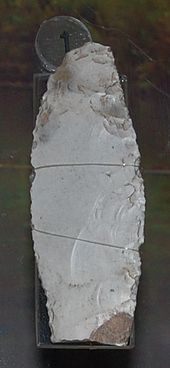- Creswell Crags
-
Creswell Crags is a limestone gorge on the border between Derbyshire and Nottinghamshire, England near the villages of Creswell, Whitwell and Elmton. The cliffs of the ravine contain several caves that were occupied during the last ice age, between around 43,000 and 10,000 years ago.
The caves contain occupation layers with evidence of flint tools from the Mousterian, proto-Solutrean, Creswellian and Maglemosian cultures. They were seasonally occupied by nomadic groups of people during the Upper Palaeolithic and Mesolithic periods. Evidence of Neolithic, Bronze Age, Roman and post-medieval activity has also been found there. The main phases of stone age occupation were at around 43,000 BC then in a period between 30,000 and 28,000 BC and then again around 10,000 BC.
Contents
The Ochre Horse
Main article: The Ochre HorseA bone engraved with a horse's head and other worked bone items along with the remains of a wide variety of prehistoric animals have been found in excavations from 1876 to the present day. The "Ochre Horse" was found on 29 June 1876[citation needed] at the back of the western chamber in the 'Robin Hood Cave'. Early excavations were carried out by Professor Sir William Boyd Dawkins, who wrote several papers on his findings.
In 2003, the Ochre Horse was estimated to be between 11,000 and 13,000 years old.[2] The site is open to the public and there is a visitor's centre.
British cave art
In April 2003, engravings and bas-reliefs were found on the walls and ceilings of some of the caves; an important find as it had previously been thought that no British cave art existed. To this day the finds at Creswell Crags represent the most northerly finds in Europe. Their subject matter includes representations of animals including bison and, arguably, several different bird species. Some workers, however, consider that the "bird" figures are more likely to be female anthropomorphs. The engravers seem to have made use of the naturally uneven cave surface in their carvings and it is likely that they relied on the early morning sunlight entering the caves to illuminate the art. Thin layers of calcium carbonate flowstone overlaying some of the engravings were dated using the uranium-series disequilibrium method, which showed the oldest of these flowstones to have formed 12,800 years ago.[2] This provides a minimum age for the underlying engraving. The scientists and archaeologists concluded it was most likely the engravings were contemporary with evidence for occupation at the site during the late glacial interstadial at around 13,000-15,000 years ago. All the caves with the engravings are situated on the Nottinghamshire side of the gorge.
Caves
The most occupied caves were:
- Mother Grundy's Parlour, which has produced numerous flint tools and split bones and was occupied until the Mesolithic;
- Robin Hood's Cave, from which was recovered the horse head-engraved bone and also evidence that its occupants were hunting and trapping woolly rhinoceroses and arctic hares;
- The Pin Hole, a prehistoric hyena den and also occupied by Neandertals. Finds include a bone engraved with a human figure and an ivory pin with etched lines;
- Church Hole, which has more than 80 engravings on its walls and was occupied intermittently until Roman times.
As a result of its unique features, Creswell Crags has been designated as a Site of Special Scientific Interest (SSSI).
It is the subject of the BBC Radio 4 documentaries Unearthing Mysteries and Nature, which can both be listened to using the links below. Creswell Crags also featured in the 2005 TV programme Seven Natural Wonders as one of the wonders of the Midlands.
In 2006/7, the B6042 road was rerouted from its former path through the Crags gorge by approximately 150m to the north to minimise traffic impact on the site.
References
- ^ The museum's exhibit label says "Leaf-points were probably spear tips. They are one of the earliest recognisable objects made by fully modern humans in Britain. This is a particularly good example. c.38-35,000 years old"
- ^ a b Hammond, Norman (7 December 2005). "Cave paintings reveal Ice Age artists". The Sunday Times. http://www.timesonline.co.uk/tol/life_and_style/court_and_social/article749449.ece. Retrieved 18 December 2010.
- Dawkins, W.B. (1877). "On mammal fauna of the caves of Cresswell Crags". Quarterly Journal of the Geological Society 33: 589–612. doi:10.1144/GSL.JGS.1877.033.01-04.35.
- Dawkins, W.B.; Mello, J.M. (1879). "Further discoveries in the Cresswell Crags". Quarterly Journal of the Geological Society 35: 724–735. doi:10.1144/GSL.JGS.1879.035.01-04.52.
- A.W.G. Pike, M. Gilmour, P. Pettitt, R. Jacobi, S. Ripoll, P. Bahn and F. Muñoz (2005) Verification of the age of the Palaeolithic rock art at Creswell, Journal of Archaeological Science 32, 1649–1655
External links
- Creswell Crags website
- BBC News article on the cave art
- Listen to a BBC Radio 4 Programme - Unearthing Mysteries
- Listen to a BBC Radio 4 Programme - Nature, The Animal Image
Coordinates: 53°15′40″N 1°11′53″W / 53.26120°N 1.19793°W
Categories:- Archaeological sites in Derbyshire
- Caves of Derbyshire
- Sites of Special Scientific Interest in Derbyshire
- Sites of Special Scientific Interest in Nottinghamshire
- Stone Age sites in England
- Visitor attractions in Derbyshire
- Visitor attractions in Nottinghamshire
- Archaeology museums in England
- Rock art in Europe
- Museums in Nottinghamshire
- 2003 archaeological discoveries
Wikimedia Foundation. 2010.





